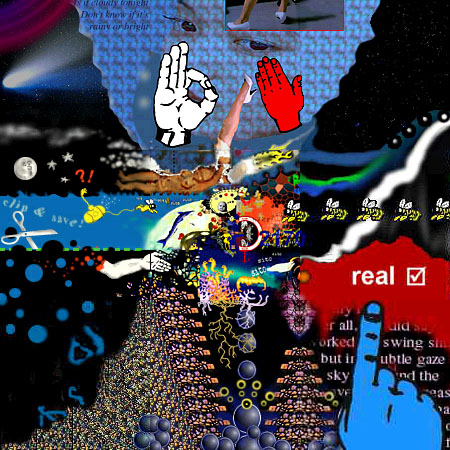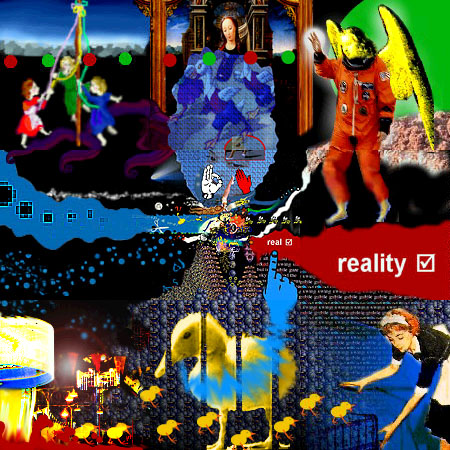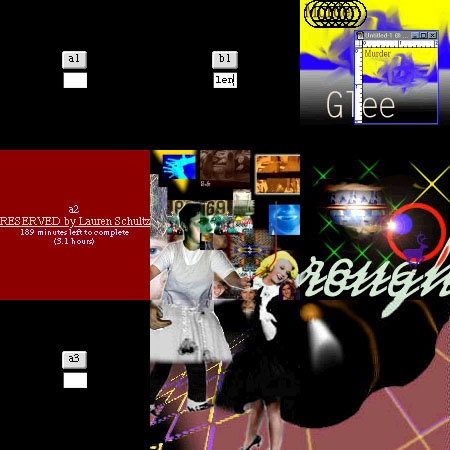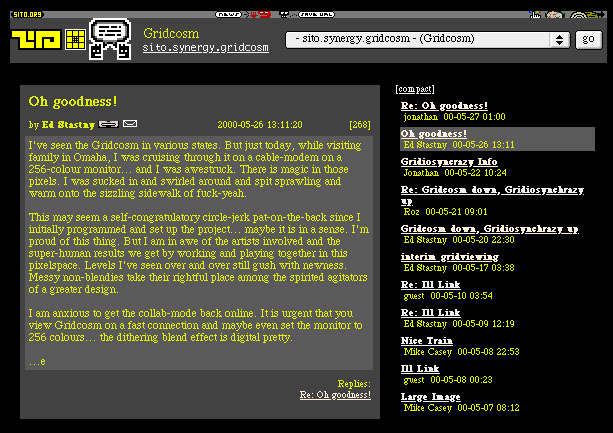
A completed level in the Gridcosm project
Keywords:
Interaction, Internet, WWW, art, collaborative art, interactive art.
Introduction
Sito is a digital art gallery and also a community of virtual artists that get together via Internet. This community creates artistic projects with the digital tools available in the virtual world. Most of the projects are done collaboratively. These works of art live in a virtual, sometimes hyperdimensional, world which is populated by "software robots" which build walls and rooms in a virtual universe, while the images are transferred, by their artists, to Sito's central computer.
The "Artchives" gallery is a showplace where artists can send their work for display. But Sito is more than just another digital gallery. There's a "collabspace" called Synergy, where many interactive projects can be found, and in which the "viewer" is teased to abandon his/her passive attitude and to work collaboratively with other artists, thus bringing about visual dialogs among themselves, which create interactive, moving, multimedia, and hyperdimensional, works of art.
The simplest way to interact is to play with the site's content. Projects are designed to allow multiple ways of browsing and manipulating images, being more of a game than merely seeing images. Possibilities are endless and unfold in different layers as the viewer/player gets familiar with the way projects work.
The next level of interaction is meeting other artists virtually, and creating visual, multimedia content for existing projects. All of them have a "collab mode", where the viewer is encouraged to become also an artist. Scripts built into the site make this an easy thing to do. Hundreds of participant artists (or "articipants" as they're called at Sito) create several new images each day which are seamlessly joined together into a big, complex piece, always expanding and growing. It's a fast, dynamic process making up a visual dialog.
An even further step would be for one to collaborate in the development of the concepts of the projects. Most of them suffer additions, improvements and even radical changes as a result of complaints, suggestions and hands-on work contributed by artists. As an ongoing process, new projects are born and grow in this way, with a great emphasis on collaboration. Therefore, instead of a single person "signing" images, or software, or concepts, we find a group of artists interacting and collaborating with each other all the time.
The key to this interactivity is Sito's flexible and open structure, made possible, in great part, by Internet's own structure, and also by participants attitude, which have them to experiment with new technologies and ideas, with an open mind, thus creating new images and new ideas for a new medium.
Sito History
Sito started as an art FTP site in January 1993. Its first goal was to provide a space for artists to show their work on the Internet, creating something similar to a digital gallery. While the gallery section - called Artchives - is still available and running nowadays, soon after its creation, Sito also began to host collaborative projects. The first projects involved serial manipulation of images by different artists, in which several "generations" of images were created, starting from "seed" images provided by different artists. The idea developed from the different initial experiences, spawning a series of projects based on the original concept. Besides the "generation" projects, another collaboration concept called "grid" was developed by Sito's artists. Instead of modifying an existing image, the grids worked by adding adjacent images to previous ones, "blending" them together in a seamless, bigger image. The grid concept was a fertile field from where many complex variations on the theme appeared, involving additions by position permutation, size shifting, connecting rules and so on. Besides the visual content, words and sounds, as well as motion, were added to the projects, trying to explore the multimedia aspect of the Internet.
Since its beginning, Sito participants encouraged freedom and experimentation, trying to use the new technologies that were made available on the Internet in a creative and artistic way. Many of the participant didn't have a "traditional" art background, and while one may argue that it could compromise the "quality" of the images, it brought many interesting characteristics to the group: a fresh view and a lack of fear of doing something "wrong" while experimenting with new techniques. The only prerequisite to join the group was to have access to the internet and the willingness to collaborate with other artists.
Nowadays, all the projects are controlled by a set of automated scripts, written together by members of the group, and regularly updated to add new features and ideas suggested by Sito's participants. This allows the projects to run continuously without the need of a human "coordinator". Once set in motion, content can be added by artists and the scripts take care of joining the images and building the pages to display them. The same scripts control the interaction with the viewers, as usually there are different ways of viewing and navigating through the content.
Levels of Interactivity
In the first level of interactivity allowed by the projects, there's just a simple form of interaction with the content - images and scripts. The viewer can create his/her own experience, with the "building blocks" provided by the artists. Besides the viewer subjective look at the piece, there's also a playful element in this experience, where the viewing process resembles a game, asking for the active intervention of the user to complete the viewing steps, and allowing different configurations for each viewing, or navigating experience. This interaction with the content is the commonest way of "interactivity" found in art websites on the Internet. But it's a very low form of interactivity, considering the possibilities available for interactive art. In this situation, there's still a big gap between the "viewer" and the "artist", where most of the creativity and action is reserved to the artist, and just a little to the viewer. Still, the viewer is not just a somewhat passive figure that looks at the art piece, but more of a "player" in an art game, designed by the artist.

A completed level in the Gridcosm project

The next completed level in the Gridcosm project
The second level of interaction takes a step further. That's when the viewer creates the visual content, becoming himself also an artist. In the process of building a collective, collaborative image, he will interact with other content creators in a form of visual dialog. In both the "generation" and the "grid" projects at Sito, the images are modified and augmented by the active collaboration between many different artists. Depending on the specific characteristics of each project, this dialog will take different forms. What happens is that instead of thinking of every image as a single, self-contained piece, the artist have to think of the image as part of a bigger whole, something connected to other images, made by different artists, completed, empathized, or even contradicted by them, in a dynamic process. The projects at Sito are built with an open, ever-growing paradigm in mind. There's not a programmed "end" for the projects, and the ones that ended did so by other reasons, mostly technical problems like scripts that didn't survive system upgrades, or imprevisible datalosses. Some of them even ended, or better said never grew, by lack of interest from the artists. Joining a collaborative process like this, means to share authorship with a group of people, not being able to write an artist signature in the bottom of the piece. This is sometimes a hard task for an artist accustomed to the contemporary art rules, where the signature and ultimately the authorship is something very valued. We see now some art projects on the Internet that allow the participants to add content, but normally a single artist retains the authorship of the concept. We can say there's some sort of hierarchy, where the "conceptual artist" is still on top, and signs the piece, and then there are the many collaborating artists that add the content to fill the conceptual artist's idea.

Working progress in hte Gridcosm project
That's when we can move a step even further and invite the participants to develop the project concept, and build an artist community with a very high level of interactivity among its participants. Inside Sito, this happens in the discussion areas, when the ideas are commented, criticized, and suggested. This a very dynamic and flexible process. Besides the "official" projects, up and running on the site web page, there are many ideas still on the testbed, ranging from whole new projects to little additions or modifications to existing ones. Those new concepts are developed by different artists, first as discussions inside the forum space, and then gradually implemented as web pages and scripts, written by the participants who have the expertise to do so, tested and refined by volunteers until they are finally "open" to the whole web community to participate. Sometimes parallel versions of one project are developed, to test new ideas, and they eventually merge or drift apart, coexisting with each other or abandoned. There might be "dissident" groups with different ideas for the same project, but normally all the discussions are resolved peacefully. It's curious to note that in many years of existence, the Sito mailing list never experienced any serious "flame burst", where angry messages with personal attacks are exchanged, an usual thing expected to happen from time to time on mailing lists. Whether due to pure luck or some group characteristic, this sure contributed to build a strong and supportive community of artists, where the openness to interaction in various levels resulted in many creative and original collaborative art projects.

Discussion about the Gridcosm project
Conclusions
From the analysis of the Sito case study, it was possible to identify three different levels of interactivity among the group participants. These levels were arranged in this paper according to their intensity, being the first level the one with the simplest, lowest form of interactivity, and the third with the more intense, complete one.
It's important to stress that the three different levels of interaction found in this case study are valid for the specific example studied. But even though this model cannot be used to analyze any collaborative art situation, the ideas about interactivity stated here can serve as a basis to further studies, possibly involving more examples, and then aiming for a more general theorization about the different processes of collaboration between artists in a computer network.
Personally for me, as a researcher, it was very rewarding to study the Sito group as a case study in my master's degree thesis, from which this short paper derives. It was for me a manner of organizing and reflecting about my experience as a participant of the group. I apologize for any inevitable "insider bias" that might tinge my views, and hope that my particular "glasses" helped more than distracted my work.
Locations:
Sito main page
http://www.sito.org
Sito artchives
http://www.sito.org/artchive/
Sito collaborative projects
http://www.sito.org/synergy
Sito discussion boards
http://www.sito.org/discussion
Lenara Verle has a Masters degree from Pontifícia Universidade Católica
do Rio Grande do Sul, and is a participant of the group Sito since 1994.
lenara@verle.com